MAKING OF ‘BRAND HITCHCOCK’
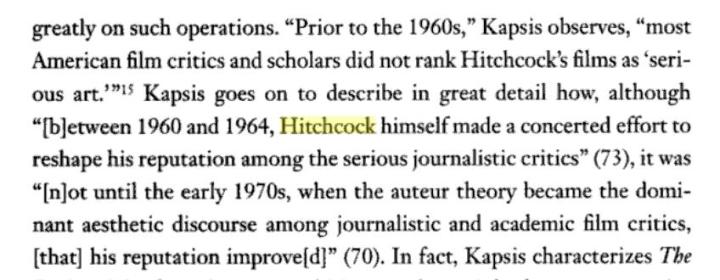
Screenshot from:http://books.google.com/books?id=bhF3-AqlWIcC&pg=PA178&dq=brand+hitchcock&lr=#v=onepage&q=brand
%20hitchcock&f=false
The screen-shot illustrated above is from the book Directed by Allen Smithee, by Jeremy Braddock and Stephen Hock. The above excerpt outlines how Hitchcock’s reputation developed over the years and points out that it was Hitchcock’s own efforts that catalysed the process. This “concerted effort to reshape his reputation” was nothing but the building of a brand image for himself by Hitchcock. Hitchcock is today essentially a ‘brand’. In lay-man terms, if you know the movie has been directed by Alfred Hitchcock, you’ll expect it to be a suspense thriller, and be entertaining. The association of his name with a film lends the film a certain quality and allows the audience to have certain expectations from it. This brand name of a ‘Hitchcock film’ developed over the years, as is indicated in the excerpt given above.
ELEMENTS CONTRIBUTING TO THE DEVELOPMENT OF ‘BRAND HITCHCOCK’:
1. Hitchcock’s sustained efforts to establish “directorial preeminence” (Kapsis 1992: 16) and to publicize himself.
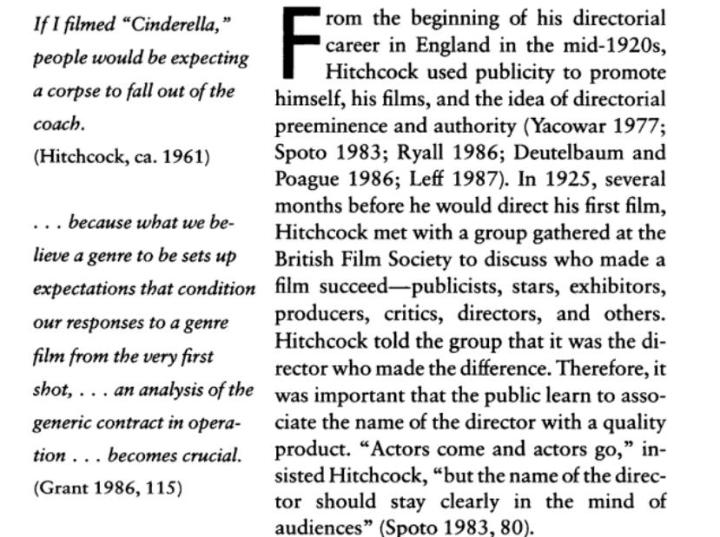
Screenshot from: http://books.google.com/books?id=mfx4PaeL1nUC&pg=PA71&lpg=PA71&dq=robert+kapsis+
hitchcock&source=bl&ots=hLsht40dE5&sig=Dhkddp99LL_-EOaZ-E_hKY0gLpY&hl=en&ei=AkP4StWiBpOh4Qa8j93SAw&sa=X&oi=book_result
&ct=result&resnum=1&ved=0CAgQ6AEwAA#v=onepage&q=prior%20to%20
the%201960s&f=false
The above screen-shot is from the book Hitchcock: The Making Of A Reputation by Robert Kapsis (The University of Chicago Press, 1992).
Even before he started directing films, Hitchcock had started propagating the view that the director should be given credit for the film’s creative content. From the very beginning of his directorial career, the reviews his movies got acknowledged his role as director, as is indicated by the following source:
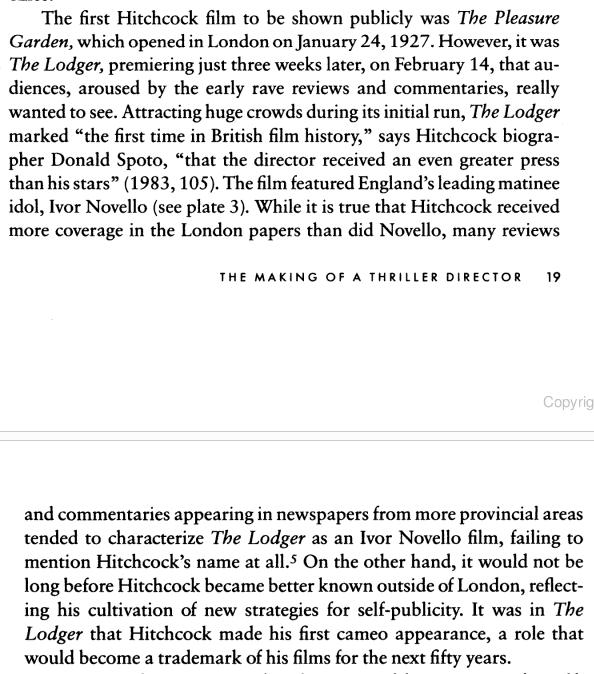
Screenshot from: http://books.google.com/books?id=mfx4PaeL1nUC&pg=PA71&lpg=PA71&dq=robert+kapsis+hitchcock
&source=bl&ots=hLsht40dE5&sig=Dhkddp99LL_-EOaZ-E_hKY0gLpY&hl=en&ei=AkP4StWiBpOh4Qa8j93SAw&sa=X&oi
=book_result&ct=result&resnum=1&ved=0CAgQ6AEwAA#v=onepage
&q=prior%20to%20the%201960s&f=false
Even in the above given excerpt, Kapsis clearly states Hitchcock’s conscious “cultivation of new strategies for self-publicity”.
When he moved to Hollywood in the 1940s, he entered a world where the producers ruled. However, even there, he did not fail to establish a mark of his own. The following excerpt speaks about the self-marketing techniques Hitchcock undertook in the 1950s, which was also the time Vertigo was made.
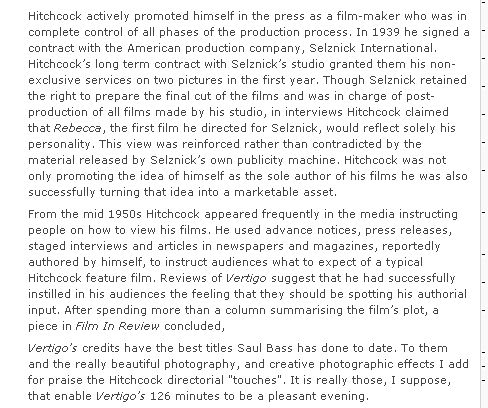
Screenshot from: http://www.typotheque.com/articles/taking_credit_film_title_sequences_1955-1965_5_spiralling_aspirations_vertigo_1958
Objectively speakiing, when it came to his films, Hitchcock’s role as director was highlighted, and the contribution of others was understated, as happened in the case of Saul Bass, who designed the titles for Vertigo (Emily King 1993, http://www.typotheque.com/articles/taking_credit_film_title_sequences_1955-1965_5_spiralling_aspirations_vertigo_1958).
In the Studio-era-Hollywood,
- Hitchcock was actively involved in the scripting and visualising process, which was unusual for directors of that time.
- He meticulously pre-planned the picture and shot it exactly as he had planned it, reducing the scope for the producer to make changes once the shooting is done, and for the editor to exercize his own discretion.
- He used actors pretty much as props, by choosing actors that were naturally conditioned for the part, and did not need to resort to their acting calibre to play the part. (Hitchcock 1995: pg 264-265)
- The titles of his films gave prominence to his name.
- He made cameo appearances in his film, which gave him familiarity with the audience and novelty.
2. The role of the critics:
Hitchcock beind considered a proponent of serious cinema, came about with the advent of the Auteur Theory, which was propounded by critics like Andrew Sarris and Francois Truffaut, writing for Cahiers Du Cinema. Hitchcock was now being considered among the top directors. Satyajit Ray writes about Hitchcock’s initial reaction to this opinion of the critics in the following excerpt from his book Our Films Their Films (Ray 1976: pg 194).
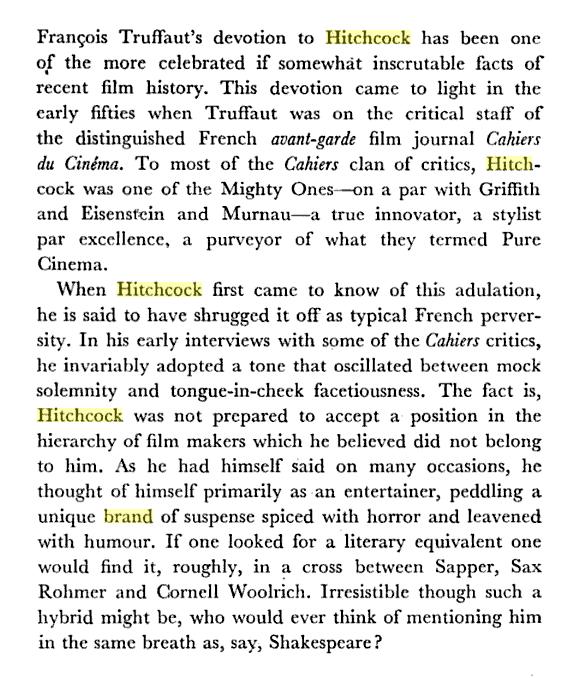
Screenshot from: http://books.google.com/books?id=t5Om460VaOQC&pg=PA194&dq=brand+hitchcock&lr=#v=onepage
&q=brand%20hitchcock&f=false
Despite shrugging off the adulation he received from the cahiers critics in the initial years, in an exhibit of rather obvious marketing, he started using the positive critical reviews to further publicize himself and his films. Take for example, the book of his interviews with Francois Truffaut. According to Kapsis, “Hitchcock envisioned the book as a vehicle to promote not only himself but also The Birds” (Kapsis 1992: 142)
Propagation of the notion of Alfred Hitchcock as an Auteur brought him a lot of recognition.
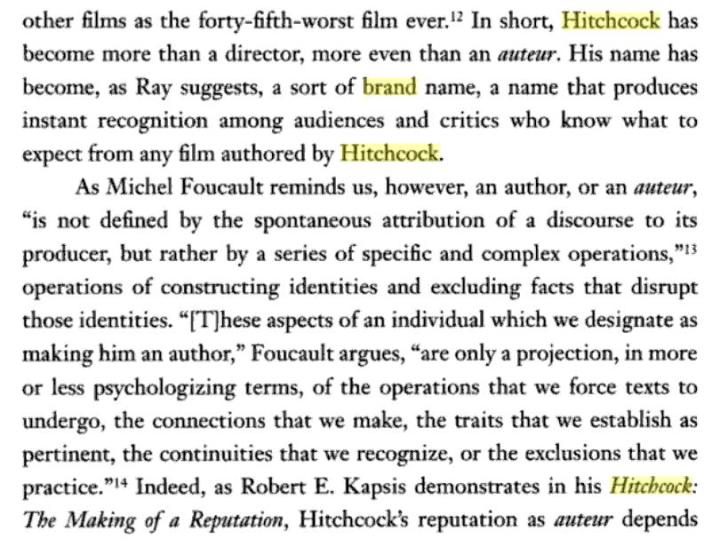
Screenshot from: http://books.google.com/books?id=bhF3-AqlWIcC&pg=PA178&dq=brand+hitchcock&lr=#v=onepage&q=interviews
%20with%20francois%20truffaut&f=false
In the above excerpt from Directed by Allen Smithee, by Jeremy Braddock and Stephen Hock, Michel Foucault answers some of the questions I had when I was analysing the Auteur theory with respect to Hitchcock. I agree with him in saying that propagation of a certain director as an Auteur conditions the audiences to look at him as an auteur, and in doing so lets them make connections and omit discrepancies in the director’s work, in order to sustain that image of him being an Auteur.
The Auteurist critics played a vital role in developing the ‘Hitchcock brand’ and sustaining it’s reputation. This is illustrated in the following excerpt from the book Directed by Allen Smithee, by Jeremy Braddock and Stephen Hock, 2001.

Screenshot from: http://books.google.com/books?id=bhF3-AqlWIcC&pg=PA178&dq=brand+hitchcock&lr=#v=onepage&q=&f=false
Not only did the critics build Hitchcock’s image, the fiercely guardeed it against any criticism.
3. Hitchcock’s branding strategies:
Shown, in the screen-shot below, is a simplified view of the branding techniques Hitchcock used.

Screenshot from: http://freelancefolder.com/the-alfred-hitchcock-guide-to-branding/
REFERENCES:
1. Jeremy Braddock and Stephen Hock, Directed by Allen Smithee, University of Minnesota Press, 2001 : pgs- 178, 179, 182, 194
2. Robert Kapsis, Hitchcock: The Making of A Reputation, University of Chicago Press, 1992: pgs- 16, 19-20
3. Emily King, Taking credit: Film Titling Sequences 1955-1965/ 5 Spiralling Aspirations: Vertigo 1958, 1993 (essay), http://www.typotheque.com/articles/taking_credit_film_title_sequences_1955-1965_5_spiralling_aspirations_vertigo_1958 accessed on 09.11.2009
4. Alfred Hitchcock, ‘Some Aspects Of Direction’ (1938), Hitchcock on Hitchcock, edited by Sidney Gottlieb, University of California Press, 1995
5. Satyajit Ray, Our Films Their Films, Orient Longman Private limited, (first edition:1976) 1993: pg-194
6. The “Alfred Hitchcock” guide to branding, http://freelancefolder.com/the-alfred-hitchcock-guide-to-branding/ accessed on 09.11.2009
leave a comment